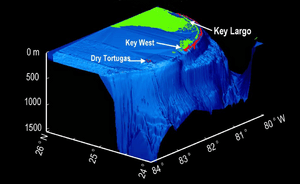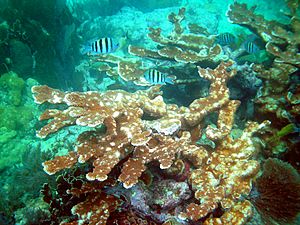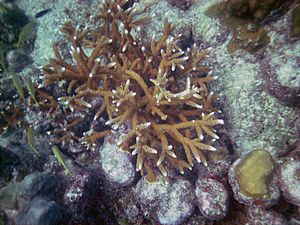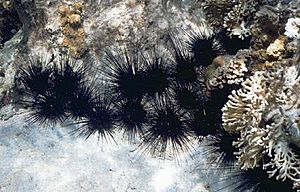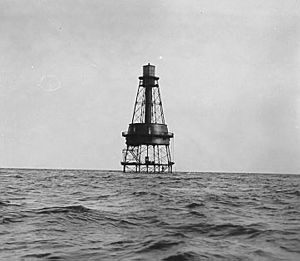Florida Reef facts for kids
The Florida Reef is the only living coral barrier reef in the main part of the United States. It's also known as the Great Florida Reef or Florida Keys Reef Tract. This amazing reef system is the third largest in the world. Only the Great Barrier Reef in Australia and the Belize Barrier Reef are bigger.
The Florida Reef is located a few miles off the coast of the Florida Keys. It stretches for about 270 kilometers (168 miles) from Fowey Rocks, near Soldier Key, all the way to the Marquesas Keys. The reef forms a big curve that follows the shape of the Florida Keys.
You can find parts of this reef in Biscayne National Park and John Pennekamp Coral Reef State Park. Most of it is protected within the Florida Keys National Marine Sanctuary. There are over 6,000 separate reefs in this system. These reefs are very old, forming between 5,000 and 7,000 years ago after the last ice age.
The clearest waters and most beautiful reefs are found near Key Largo and Elliott Key. These long keys help protect the reefs from water coming from nearby bays. Water from these bays can be less salty, cloudier, and have changing temperatures. This makes it harder for corals to grow.
Contents
Reef Structure and Communities
The Florida Reef has two main parts. Closer to the Florida Keys is a sandy area called White Bank. It's covered with large beds of sea grass and has many small, scattered reefs. Further out, towards the deep ocean, is the second part. This outer ridge forms the main reefs, made of corals, broken coral pieces, and sand.
Almost 1,400 different kinds of ocean plants and animals live on the Florida Reef. This includes over 40 types of stony corals and 500 kinds of fish. Even though Florida is at the northern edge for tropical corals, the variety of species here is similar to other reefs in the Caribbean Sea.
The Florida Museum of Natural History describes three main living areas on the Florida Reef:
Hardbottom Community
This area is closest to the Florida Keys. It has mostly algae, gorgonians (like sea fans), and stony corals. These grow on limestone rock that has a thin layer of sand. Common corals here include smooth starlet coral and mustard hill coral. This hard bottom is home to anemones, mollusks, crabs, spiny lobsters, seastars, and many fish. Some fish you might see are grunts, snappers, groupers, and Great barracudas.
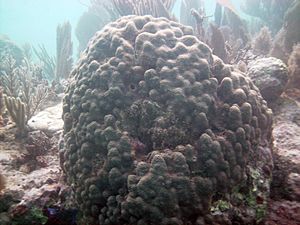
Patch Reef Community
Patch reefs are small, separate reefs that grow in shallow water, usually three to six meters (10 to 20 feet) deep. They start when corals grow on a hard bottom. Then, new corals grow on the skeletons of dead corals, making the reef grow upwards. Most patch reefs are built by star corals and brain corals.
Patch reefs can grow all the way to the water's surface and spread out. Some are round or oval, like Hen and Chickens. These are usually less than three meters (10 feet) tall. They are surrounded by sand, kept clean by long-spined sea urchins and fish that eat grass. Other patch reefs are long and thin. These often have elkhorn coral, which is less common on the round ones.
When old coral skeletons get weak, parts of a patch reef can break off. Patch reefs are great homes for spiny lobsters and many fish. You might see Bluehead wrasse, damselfish, French and queen angelfish, yellowtail snappers, parrotfish, and sergeant majors.
Bank Reef Community
Bank reefs are larger than patch reefs and are found on the outer edge of the reef system. They have three main areas:
- The reef flat is closest to the Keys. It's made of coralline algae growing on pieces of coral.
- Further out are the spur and groove formations. These are low ridges of coral (the spurs) separated by sandy channels (the grooves). In the shallowest parts, you'll find fire corals. Deeper down, elkhorn coral, star corals, and brain corals are common.
- Beyond this is the forereef, which slopes down into deeper water. The upper part of the forereef has lots of star coral. Deeper down, where there's less light, you'll see flat, plate-like corals, sponges, and other corals that don't build reefs.
Bank reefs are home to fish like French angelfish, blue and queen parrotfish, Queen triggerfish, and snappers. The sand around the Florida Reef is made of bits of shells, coral skeletons, and limestone.
Other common corals on the Florida Reef include Ivory Bush Coral, staghorn coral, and lettuce coral.
Individual Reefs
Here are some well-known reefs in the Florida reef system:
- 9-foot Stake (reef)
- Alligator Reef
- Ajax Reef
- Carysfort Reef
- Cheeca Rocks (reef)
- Coffins Patch (reef)
- Conch Reef
- Crocker Reef
- Davis Reef
- Dry Rocks (reef)
- Eastern Dry Rocks (reef)
- Eastern Sambo (reef)
- French Reef
- Grecian Rocks (reef)
- Hen and Chickens (reef)
- Looe Key
- Marker 32 (reef)
- Molasses Reef
- Newfound Harbor Key (reef)
- Pacific Reef
- Pickles Reef
- Rock Key (reef)
- Sand Key (reef)
- Snapper Ledge (reef)
- Sombrero Key (reef)
- Tennessee Reef
- The Elbow (reef)
- Turtle Reef
- Western Sambo (reef)
Threats to the Reefs
Coral reefs are super important because nearly 25% of all ocean life lives on them! But these amazing places are in danger. They are being harmed by pollution, too much fishing, and climate change.
Tiny pieces of plastic floating in the ocean, called microplastics, are eaten by coral polyps. These polyps are the tiny animals that build the reef structure. When they eat plastic, they can die.
Overfishing also hurts the reefs. Fish that eat algae are important because they keep the algae from growing too much and covering the corals. If there aren't enough of these fish, the corals can get smothered.
The biggest threat to coral reefs is changing ocean temperatures caused by global warming. When the water gets too warm or too cold too quickly, corals get stressed. They lose their food and turn white. This is called coral bleaching. This can kill the corals.
When these fragile ecosystems are damaged, it can lead to big problems. Many ocean animals could disappear forever. Fishing industries could suffer, and coastlines could be damaged by coastal erosion.
The Florida Reef, like many reefs around the world, is showing signs of stress. For example, the numbers of Elkhorn and Staghorn corals have dropped a lot. At Molasses Reef, Staghorn corals decreased by 96% between 1981 and 1986.
Coral bleaching has become more common since the first one was recorded in 1973. This is linked to rising sea surface temperatures. Diseases like white band disease also harm corals. While hurricanes can cause some damage, the widespread loss of corals isn't just from storms. Other problems include pollution, too much fishing, boats hitting the reefs, and seaweed growing on corals.
The long-spined sea urchin used to eat a lot of seaweed on the reefs. But their numbers dropped sharply in the 1980s. This means there are fewer urchins to keep the seaweed in check. While the loss of urchins didn't cause the corals to die off, it might be slowing down their recovery.
Another threat is the ongoing rise in sea level. The sea level at Key West has risen about 15 centimeters (6 inches) since 1913. This means more water flows from Florida Bay over the reefs. This bay water is less salty, cloudier, and has more changing temperatures, which is bad for the corals.
People started worrying about the reefs in the 1950s. Efforts to protect them led to the creation of John Pennekamp Coral Reef State Park in 1960. Later, Biscayne National Park was created in 1968. In 1990, the Florida Keys National Marine Sanctuary was established. Now, almost all of the Florida Reef is under federal or state protection.
Human Use
Many people enjoy visiting the Florida Reef. This is very important for the economy of southern Florida. In 2000-2001, about 28 million visits were made to the reefs for fun activities. People went scuba diving, fishing, and snorkeling. These activities brought in a lot of money and created many jobs.
In Monroe County, where the Florida Keys are, reef activities brought in over $500 million and supported 10,000 jobs. About half of these activities were fishing, and a third was snorkeling.
Shipwrecks and Lighthouses
The Florida Current flows very close to the Florida Reef. This strong current, combined with dangerous reefs, made the area a common place for ships to crash.
Ships started wrecking here soon after Europeans arrived in the New World. Spanish ships returning from the New World often sailed close to the Florida Reef to catch the Gulf Stream. In 1622, six Spanish treasure ships sank during a hurricane. In 1733, another 19 Spanish treasure ships were lost in a hurricane.
By the 1800s, this area was a major shipping route. Ships were wrecking almost once a week! Between 1848 and 1859, at least 618 ships crashed on the Florida Reef. Saving items from these shipwrecks was a main job in the Florida Keys for a long time. This even made Key West the biggest and richest city in Florida for a while.
Some reefs are named after ships that wrecked on them. For example, Looe Key is named after HMS Looe. Alligator Reef is named after the USS Alligator.
After the United States got Florida in 1821, they started building lighthouses. The first lighthouses on the reef were lit in 1825. But keeping them working was hard. Some were destroyed by hurricanes or attacked.
Starting in 1852, new lighthouses were built right on the submerged reefs. These were tall, metal structures called skeletal towers. By 1880, with the completion of the American Shoal Light, there were finally enough lights to guide ships safely along the entire Florida Reef.
To help ships even more, the Florida Keys and the reefs were carefully mapped in the 1850s. Scientists like Louis Agassiz also studied the reefs to understand them better.
See also
 In Spanish: Arrecife de la Florida para niños
In Spanish: Arrecife de la Florida para niños


